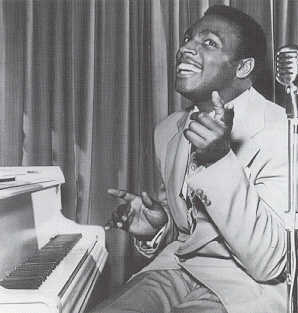Charles Brown (Tony Russell Brown)

In the late 1940s, a rising demand for blues was driven by an increasing white teenage audience in the South which quickly spread north and west. Blues singers such as Louis Jordan, Wynonie Harris and Roy Brown were getting much of the attention, but what writer Charles Keil dubs “the postwar Texas clean-up movement in blues” was also beginning to have an influence, driven by blues artists such as T-Bone Walker, Amos Milburn and Charles Brown. Their singing was lighter, more relaxed and they worked with bands and combos that had saxophone sections and used arrangements. Charles Brown left the Three Blazers in 1948 and formed his own trio with Eddie Williams (bass) and Charles Norris (guitar). He signed for Aladdin Records, and had immediate success with “Get Yourself Another Fool”, before having one of his biggest hits in 1949 with “Trouble Blues”, which stayed at number one on the Billboard R&B chart for 15 weeks in the summer of 1949. He followed up its success with “In the Evening When the Sun Goes Down”, “Homesick Blues”, and “My Baby’s Gone”, before having another R&B chart-topping hit with “Black Night”, which stayed at number one for 14 weeks between March and June 1951. His final hit for several years came with “Hard Times” in 1952. Brown’s approach was too mellow to survive the transition to rock and roll’s harsher rhythms, despite recording in Cosimo Matassa’s New Orleans studio in 1956, and he faded from the national limelight. Though Charles Brown was unable to compete with the more aggressive sound that was increasing in popularity, he managed to maintain a small, devoted audience. Additionally, his songs were covered by the likes of John Lee Hooker and Lowell Fulson
Charles Brown’s “Please Come Home for Christmas”, a hit in 1960 on the King Records remained seasonally popular. “Please Come Home for Christmas” sold over one million copies by 1968, and was awarded a gold disc in that year. During the 1960s Brown recorded a couple of albums for Mainstream Records. In the 1980s he made a series of appearances at New York City nightclub Tramps. As a result of these appearances he signed a new recording contract with Blue Side Records and recorded One More for the Road in three days. Blue Side Records closed soon after but distribution was picked up by Alligator Records. Soon after the success of One More for the Road, Bonnie Raitt helped usher in a Charles Brown comeback tour. Charles Brown began a recording and performing career again, under the musical direction of guitarist Danny Caron, to greater success than he had achieved since the 1950s. Other members of Charles’ touring ensemble included Clifford Solomon on tenor saxophone, Ruth Davies on bass and Gaylord Birch on drums. Several records received Grammy Award nominations, and in the 1980s he toured widely as the opening act for Bonnie Raitt. Charles Brown died of congestive heart failure in 1999 in Oakland, California, and was interred at Inglewood Park Cemetery, Inglewood, California.
Born
- September, 13, 1922
- USA
- Texas City, Texas
Died
- January, 21, 1999
- USA
- Oakland, California
Cause of Death
- congestive heart failure
Cemetery
- Inglewood Park Cemetery
- Inglewood, California
- USA



